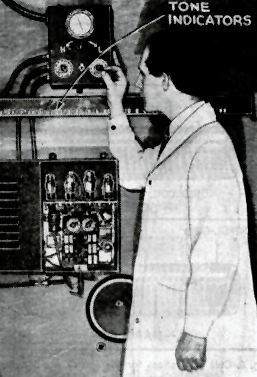Instruments
Theremin “Terpsitone” A New Electronic Novelty
An article from Radio Craft magazine originally published on december 1936.
By means of Prof. Theremin’s latest device, a dancer may create music by the movements of her body. A capacity device in the floor is mainly responsible.
The inventive genius of Professor Leon Theremin has at last justified a famous poet in his license. Many years ago, Tennyson wrote:
– “The dancers dancing in tune.”
And a distinguished musical critic commented: “That would be beyond the abilities of the young lady of Banbury Cross” who, as will be remembered, had “rings on her fingers and bells on her toes.”
But by the new electrical system of Theremin, which depends, like the original device named for him, on the phenomenon known as “body capacity,” it is possible for a dancer to dance in tune as well in time. In place of the rods used in the first “Theremin,” there is an insulated metal plate beneath the dancing floor. As the dancer bends towards it, the electrical capacity is increased, and thereby the pitch of an oscillating tube circuit is lowered; as she rises on tiptoe, for instance, the pitch of the oscillator is increased. The output of this oscillator is beat against that of another of fixed tune, producing an audible (not superhet.) frequency and this is amplified and fed into a large, square reproducer. Thus the motions of the danseuse are concerted into tones varying in exact synchronism with her pose. In fact, the motion of either an arm or a leg is sufficient to produce a noticeable change of tone. The loudspeaker used to give this individual tone interpretation of the dance is supplemented by another, reproducing a background of the theme music previously selected.
It need hardly be said that there is a great deal of scope for individual talent in coordinating bodily movements so that the sound thus produced will not only fall pleasantly upon the ear, but also combine harmoniously with the preselectd phonograph records. In other words, this is a field of pure artistry.
Another feature combined with it is an automatic colored light accompaniment. The “visual note indicator” is a panel of lamps of different colors. This, however, is accomplished by a method partly mechanical; a tuned reed behind each lamp vibrates when its corresponding note is sounded, and thereby closes the circuit lighting its lamp. Thus the notes evoked by the artist’s motions are shown by lights flashing simultaneous up and down the panel; one for “A,” another for “C,” and so through the gamut.
The wall apparatus, shown in the illustrations, contains 4 tubes: 2 oscillators, one of constant pitch (after it is set), and one varied by the movements and altered capacity of the metal plate attached to its grid circuit; 1 mixer, or modulator tube, and audio-frequency amplifier. Below these are the transformers and tuned coils. In the control panel above, there are volume and tone controls, including one for the vibrator which operates the “visual note indicator” lamp panel.

We have thus a new instrumentality of the terpsichorean art, as well as the lyric, combining the best features of both; and permitting even greater expression of individuality, as well as demanding even more refined technique. And all from another extension of the principle of “hand capacity,” which used to be such a nuisance to the seeker after DX.

Radio Craft, december 1936.
















